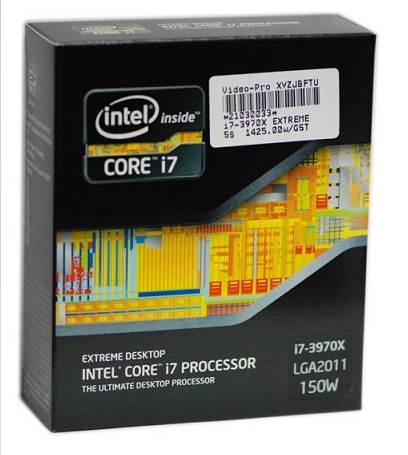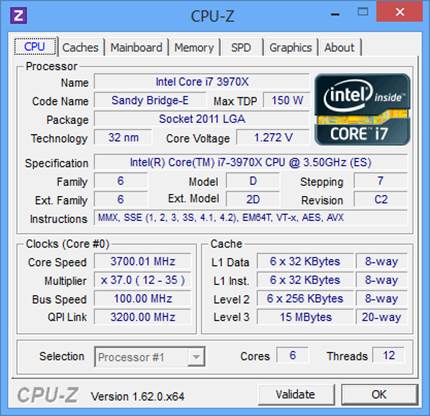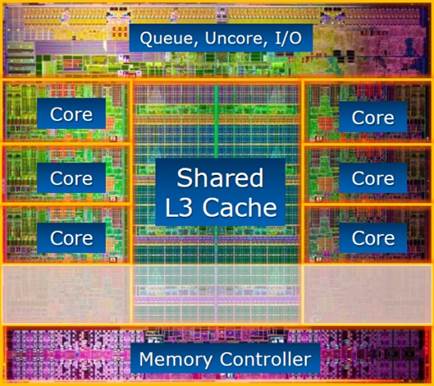Intel Core i7-3960X used to be the most
responsive microprocessor for high-performance desktop systems in 2011. But
it’s time for it to step back: Intel released Core i7-3970X Extreme Edition. Though
the new product had no difference with its predessesor, we decided to bring it
to the feature-detailed and performance benchmarks in our lab.
Computer enthusiasts, who prefer
traditional desktop systems to the new fancy utilities and mobile computers,
may have felt pretty forgotten lately. Desktop microprocessors are gradually
stepping back into secondary positions for AMD and Intel, while the companies’ preferential
efforts are targeted towards application of the existing solutions for all pocket
systems, such as micro-servers, nettops, ultrathin notebooks, tablets and
smartphones. High performance isn’t the final goal for the new generations of
microarchitectures until now, with low power consumption and functional
integrated graphics becoming the major determinative factors.

Intel
Core i7-3970X Extreme Edition Processor
In this situation, new desktop microprocessors
started to pop out less frequently, and their performance development slowed
down remarkably. Moreover, there are some rumors that Intel wants to make a
bold move against the untouchable feature - the possibility to upgrade by
replacing the CPU in the mainboard. Does this mean the low dead of desktops? I
don’t think so: high-performance computers will always be necessary, especially
because many users are eager to pay for such kind of high performance. We can
imagine that Intel want to introduce fully integrated, non-upgradable platforms
in the lower price segment, but the potential enthusiast systems will still
stay in their current form for a very long time.
Take the leading desktop LGA 2011 platform
as an example. It has no competitors; AMD has left this niche for interest for
a long time. Still, Intel continues to zelously support the existing
infrastructure and not only for the reasons of company’s reputation. There are also
likely some efficient financial reasons here. On one side, the development of
desktop LGA 2011 systems doesn’t require big investments: this desktop platform
has the same united design as server and workstation solutions. On the other
hand, all of these devices are considered high-end products with high revenue
margins.
Intel is clearly interested in continuing
with LGA 2011. This platform doesn’t just exist but develops fast. For
instance, they continuously launch new microprocessors for it and not only when
the new microarchitecture pops out. Even mothermoard systems cannot renew the
programs frequently in a self-conceited way like these days, LGA 2011 has everything.
They purposefully maintain the same traditional system of values, requiring the
manufacturer to show love for their users from time to time.
One of the innovations like that is the
reason for this review. Intel decided to honor their enthusiastic fans of the
high-performance systems and launched a new LGA 2011 micromicroprocessor - Core
i7-3970X Extreme Edition that replaces the previous top CPU - Core i7-3960X,
which stayed in this leading place throughout a year. However, the new Core
i7-3970X was launched by a very old-fashioned manner, because in fact it is nothing
different than a legally overclocked previous CPU model. This “new” CPU has not
only the same core microarchitecture and manufacturing process, but also the
same microprocessor modified vision of the semiconductor die. In fact, there is
no way to really increase the frequency capability of this microprocessor that
is why higher clock speed leads to higher heat dissipation and higher TDP.
However, the major target group for this type of products, which typically use
high-tech cooling solutions, will hardly be upset about it. They will be much
more excited about a different aspect: how big a performance enhancement will be
and how much better the new microprocessor will overclock. So, we will try to
answer these questions to the extent of our ability in this review.
Approach Core i7-3970X
Because the new Core i7-3970X microprocessor
is built on the same semiconductor die as the previous top LGA 2011 six-core
CPU, it is fairly easy to describe the new microprocessor in just a few short
paragraphs. In fact, we are working with a legally overclocked Core i7-3960X,
which clock frequency on-behalf has increased from 3.3 GHz to 3.5 GHz, and the
frequency in Turbo mode - from 3.9 GHz to 4.0 GHz. Besides the frequencies, the
heat dissipation features have also changed: the thermal cover of the new Core
i7-3970X is set at 150 W, while the predecessor product had a TDP of only 130
W. There’s only 1 difference between the old and the new top LGA 2011 microprocessors.
As before, the CPU is based on a 32 nm Sandy Bridge-E microprocessor die with
six computing cores, a giant 15 MB L3 cache and quad-channel memory controller.
Besides, it also supports Hyper-Threading that lets Core i7-3970X process up to
12 streams at the same time.
The table below summarizes everything for
your convenience:

Core
i7-3960X’s and Core i7-3970X’s technical specs
Although there are very few differences in
the technical specs of Core i7-3960X and Core i7-3970X, Intel could make a few
lower-level changes, but they chose not to do that. Just like the predecessor
product, the new Core i7-3970X uses C2 microprocessor springboard with eight
computing cores, both of which are disabled. You can easily see that from the predicted
utilities reports:

The
new Core i7-3970X uses uses C2 microprocessor springboard with eight cores.
I would like to remind you that the signature
feature of C2 microprocessor springboard is the operational CT-d technology,
which was disabled in the first LGA 2011 microprocessors because of some
implementation errors. This is exactly why they then renewed the core design a.
So far, there has been no other core springboard for Sandy Bridge-E microprocessors,
so we can’t really expect any expectation from the Core i7-3970X.

The
increase of heat dissipation is nothing to be surprised.
Even the increase in the heat dissipation
is nothing to surprise. Intel has already used this card in their symmetrical
Xeon E5 lines, so they chose the time-tested route for the inovation of their
desktop microprocessor program. In the server CPU lines Intel increass the TDP index
of the top eight-core Xeon E5-2687W microprocessor. However, they believe that
the desktop Core i7 don’t deserve to have 8 cores. Therefore, in our case, it is
simply the increases clock frequency.
The increase in the max TDP limits hardly
changes anything for the top desktop LGA 2011 systems. The mainboards voltage
regulator circuitries and LGA 2011 cooling systems have been designed for
overclocking purposes from the start. Therefore, Core i7-3970X is fully
compatible even with the first-generation devices, with only one exception,
which is Intel’s own RTS2011AC air cooler, which was highly recommended with
LGA 2011 microprocessors. In other words, the new Intel microprocessor should
have no compatibility issues.